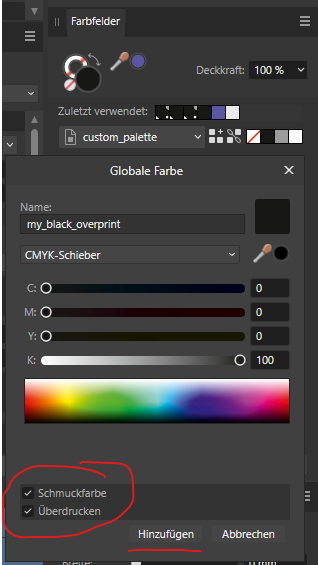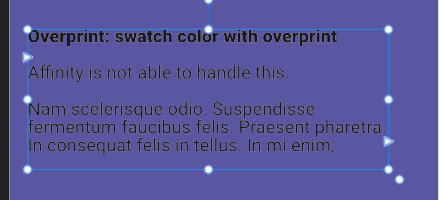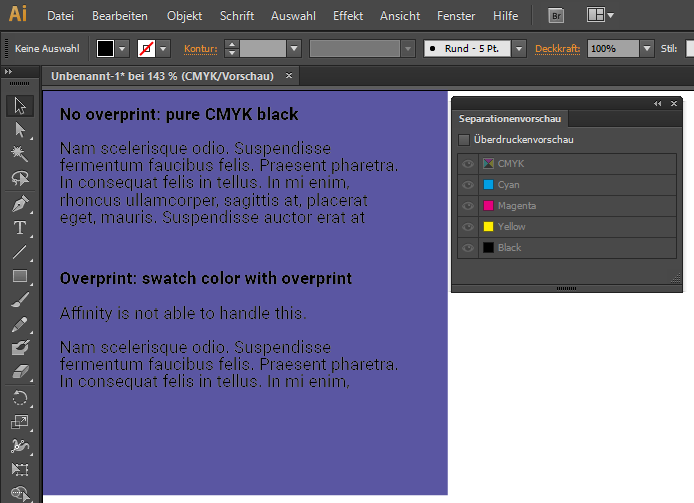Search the Community
Showing results for 'Separation preview'.
-
Affinity doesn't have a separation feature, thus there are only workarounds yet. • Video tutorial: Extracting RGB, CMYK and LAB Into Separate Layers Using Channels (in Affinity Photo) • @NotMyFault created a set of Adjustments to separate CMYK as layer settings: https://forum.affinity.serif.com/index.php?/topic/164280-feature-request-channels-preview/#comment-935402 • @aepasek made a video demonstrating a separation process for RISO print (which uses Spot Colours, like your screenprint possibly): https://forum.affinity.serif.com/index.php?/topic/161161-clipping-layers-for-riso-design/#comment-919111 • If you want to print or export Selected Layers only you can set their layer visibility accordingly. In AD and APh you have alternatively the Export persona to choose output layers and elements.
-
Hi Nathan, two PDFs are placed in InDesign. Left page - PDF from Publisher with customer ads, right page - PDF exported from InDesign with the same customer ads. If you switch on Separation Preview in InDesign, you can see the differences. On the screenshot with black switched off you can see that black is separated from Publisher, whereas on the right side black is not visible (switched off). The Ad (Zöller) is created in Affinity Designer with the same profile as in the Publisher export, so it is separated correctly. If I create this Ad with the other profile as in Export from Publisher, black is also separated as 4c. The setting in Publisher for Ads - Content/Passthrough. This is the problem - In advertisements from clients, black is separated in 4c. Do you understand what I mean?
-
Alright, so the v2022 trial has the separation preview, unlike v2021. Aaand it has PDF/X-4 preflight. But… Yep, it reads spot as CMYK. So… close but no cigar. Back to my Automator Service plugin to run Ghostscript. (Note to self: I should finally fix the bugs, finalize it and release it…) Let's see if spot color separation will be added as a "big new feature" for v2023…?
-
@Vosje Maybe you mean overprint ? Here is the online help for this topic: https://affinity.help/publisher2/en-US.lproj/index.html?page=pages/Clr/overprint.html?title=Overprinting Unfortunatley Affinity seems not to be able of simulating overprint in the viewport? If anyone knows - please show the trick. I can reproduce the fault The "halo" appears as soon as you change the document color format to CMYK. If you work with RGB everything looks ok in the viewport. Document RGB: Document CMYK: Of course you will set the document color format to CMYK when working on a document targeted for CMYK offset printing. I tried the following steps - following the Affinity help on spot colors with overprint (https://affinity.help/publisher2/en-US.lproj/index.html?page=pages/Clr/overprint.html?title=Overprinting). In my example the upper textframe has pure CMYK black: The lower textframe has my spot color: Visually there is no difference in the viewport. Furthermore this aproach would be dangerous because now you have a spot color in your document that produces an extra color separation. You would have to be aware to untick the advanced option in PDF export prefs to finally have pure CMYK colors: Unfortunately there is still no color separation | overprint preview in Affinity, to carefully check if you have done your preprint work properly. Here is how this looks like e.g. in Illustrator: By the way - this is NOT a nice to have in a professional DTP Software. This can be vital to avoid misprints that your customers will hold you accountable for. Sorry, can't get rid of these two screenshots in the forum editor here ???????????
-
I admit that I haven't have to use bitmap images in layouts literally in decades. When I received one from a client, I traced it in Illustrator. They were never that complex that it wouldn't be possible, even though AI CS5 would usually take its time to make all those calculations, and some manual cleanup was usually also necessary. Also frankly, I don't work at a print company. All I can do now is to preflight the PDF/X-3 or PDF/X-4 that I'm usually sending to the print guys, and hope they will be able to work with it. If not, they would give me feedback. And from what I can see in Acrobat, my above "Jazz" example should apparently work as intended. So, I just opened the 1-bit Affinity non-alpha-PNG-converted-to-bitmap-TIFF-via-MacOS in PS: And then I opened the original RGB JPEG in PS and converted it to Bitmap: No alpha channel either because the Bitmap mode requires flattening to Background layer. (The threshold adjustment value * was likely not the same, hence the image looks slightly different.) The only difference is that saving from PS saves space because you can choose LZW or ZIP compression, whereas the MacOS conversion from 1-bit PNG to TIFF via Automator is uncompressed. *) As a side note: Why the heck is the Affinity Threshold adjustment value in %?! Why not 0 to 255?! WTF? I know, it's much easier to work with. Also separation preview, overprint preview, overprint as an object attribute, yada yada. Been working primarily with ID from 2003 until 2020. We all desperately want to have that in Affinity as well! Nobody is trying to excuse Serif that those features are not needed. But if needed, it's possibe to work around the limitations to a certain degree.
-
Overprint preview
Amvjb replied to jocstone's topic in Feedback for Affinity Publisher V1 on Desktop
+1 For overprint colour preview & CMYK colour separation preview. -
I would wish for a way to preview color separation without the need to use Adobe software or other commercial third party software. Another solution could be a new application from Affinity for this purpose. Ralf Maeder
-
I would wish for a way to preview color separation without the need to use Adobe software or other commercial third party software. Another solution could be a new application from Affinity for this purpose. Ralf Maeder
-
@zuzi I found PackZview that do separation preview and more on PDF like Acrobat pro. It still free but for how long because it's so good. A separation Preview in Publisher is a good idea for preflight BUT it's often the export to PDF that mess the thing. You have to keep the same color profil along every file you use or import in your publisher. Then in export keep the same profil. If you change your profil at export your color will be "destroyed" I also use PDFX 3 and 4 to keep my black "BLACK" and Pantone when needed. Having 100% black in Affinity suite is a nightmare and should always be checked when going on offset press.
- 7 replies
-
- prepress
- colour separation
-
(and 1 more)
Tagged with:
-
Hi, does Affinity allow for: 1. Overprint - I need to overprint certain colours for final print output. 2. Overprint Preview 3. Separations Preview - this is vital in seeing the final output of colours prior to going to print (other than printing physical seps). 4. Spot Colours - In the interim, does Affinity support spot colours - even if its not Pantone Book colours, I then can name it a pantone for the printers reference.
- 5 replies
-
- Overprint
- Separation
-
(and 3 more)
Tagged with:
-
Hey you, thanx a lot for porting publisher to ipad. I found out that: 1. Tables: I cannot create a table format, there is no such a dialog, but table-formats created on mac are saved with the document and can then be opened on ipad 2. Rulers: there are no rulers neither above nor left, but I found the guides. 3. when I change the curve of one selected photo (with studio link) the complete page is changed, not only the selected picture, on mac this works finely. 4. no separation preview, this is a feature request, the same in the macversion, a lot of people are missing it 5. some problems with overprint black and pdfx 4 export, the same in the macversion (just the same in Version 1, no change unfortunately), I reported this earlier on Version 1.
-
Affinity Photo 2.0 Crashing/Closing all the time
Manua replied to raphaelbonelli's topic in V2 Bugs found on Windows
Yes, I kept the Quadro P2000 as the renderer. With Open CL OFF it is responsive at the beginning but become buggy and slow when editing panoramas (100mpix and more), pictures with more than five or six layers, or when doing frequency separation and using the mixer brush. The brushes, toggling the visibility of layers, switching to another tool become slower. But the most annoying issues are the freezes, it's like a sleep behavior, where the mouse pointer stay with the brush preview when I'm trying to select another layer, tool, or the assistant robot icon. Going in another app to come back in AP2 seem to wake it up, but frequently it become completely unresponsive and I have to force close it. But maybe I have just found a solution, I disabled Windows Ink in wacom app and it looks like it make a difference in the software. Can't be sure yet because I'm just trying with few layers, I have to try it in a real case scenario. Settings are: Windows Ink in wacom app untick; Pref/Performance Quadro P2000 as the renderer, retina on auto, Open CL Off; Pref/Tools "High precision". I will investigate further the software with these settings, if it's working like a charm I will know there is a conflict with Windows Ink in wacom software. Thanks for this information. If the new settings are not working well I will open a new thread. Thanks again @SrPx for your help. -

How to show red overlay when masking
loukash replied to user_0815's topic in Feedback for the Affinity V2 Suite of Products
Yes, there are many factors to be considered when doing business. But I didn't have the impression yet that Serif is even targeting the Affinity suite at such audience. For example, I work alone since 35 years, so I am free to choose whichever tool I like. As such, my only concern is PDF compatibility with the print shops I send my files to. Since they all seem to get along with PDF/X-4 just fine, Affinity does the job for me (also knowing its quirks with PDF export by now, d'oh!). Heck, meanwhile I even have a workable solution on MacOS Catalina to get along without Acrobat X for preflight and separation preview, by using a mixture of other somewhat limited but free/demo PDF editors and a scripted Ghostcript workflow. It works, and it didn't cost me a penny yet. Anyway… -

Color Separations View
NotMyFault replied to tnichols's topic in Feedback for Affinity Publisher V1 on Desktop
You can preview color separation in Publisher and Designer: -
Color Separations View
thadeusz replied to tnichols's topic in Feedback for Affinity Publisher V1 on Desktop
Guys, there are dozens of threads for this topic. As long as Affinity is so unprofessional in this specific field, there are only workarounds. I hope, but don't belief a separation preview is coming soon, as many of us where demanding this from day 1. I'm using a little program called PACKZVIEW, which is free and does the job:(https://www.packz.com/downloads-info/ Especially when using spot colors there are problems keeping colors as spot and not converting to CMYK. Keep an eye on a consistent color profile and only using multiply, transfer or normal as layer blend mode. I've wrote about my way to this quite stable workflow in this forum. So please don't be shy and have a look... 😎 -
Hi. I created manually a huge collection of simulated pixel art. There is a bunch of more than 8 thousand individual pieces that Affinity couldn't manage in one fils, so I have spliced them in files that contains between 400 to less than 600 artboards, each containing one piece. Despite the files are hardly managed by my old laptop, I tried for first time the persona export because up to date I never had to make so massive amount of files. So each artboard, a perfect square of 1008 by 1008 pixels containing colored rectangle shapes of 24px side, perfectly aligned by Affinity snap fitting perfectly inside the square as a different image. I will not upload full size screenshots, but the issue will be clear. Designer persona shows squares like separated in preview. in outline view they are shown with no space at all between, no matters the magnification. Export directly one by one from designer results in a perfect 1008px square, with no separation between the colored squares, but export persona DOES! it export each artboard in 1009px and with a clear separation of 1 px between squares!!! so is totally unusable to export my more than 8 thousands figures!!!! that is not only frustrating, is very imprecise. Note I "adjusted" one to 1008px to test, but the result is very bad too, so I need your help, pleas as soon as possible.
- 8 replies
-
- export persona
- png
-
(and 3 more)
Tagged with:
-
The Acrobat separation preview ICC profile must match the embedded profile. Unless you export PDF/X, then Acrobat will usually know what to do with the embedded profile. Or do not embed the profile if you use e.g. the "PDF for print" export preset. Then the PDF should retain the absolute CMYK values.
-
FYI It seems that Qoppa does not recognize the spot colors on the color separation preview.
-
Did you install the Pro version? https://kbpdfstudio.qoppa.com/video-output-preview-and-color-separation/
-
Is that new? I just downloaded the 2021 demo because I may need MacOS El Capitan compatibility, but there's no separation in the demo, only preview. Also, I don't see any PDF/X-4 preflight options. That would be a dealbreaker.
-
Bought it some months ago. Current version (2022) has colour separation preview. Its worth a try.
-
Bonjour à l'équipe, bonjour à toutes et à tous, dans la continuation de sujets sur l'affectation de couleurs de tons directs et la séparation, il y a plusieurs questions qui me "travaillent" concernant Publisher. Envisagez-vous : - une palette d'aperçu des séparations de couleurs (genre on peut voir les différentes couches) ? - un aperçu de la surimpression (qui peut être lié à la question précédente) - une palette d'info ou de mesure des différentes couches ? - la possibilité de créer des couleurs composées/mélangées* (mélange de primaire et/ou tons directs) ? Indispensable pour faire bonne impression Merci. *C'est l'idée générale ! ***** Hello to the team, hello to everyone, In the continuation of topics on spot colour assignment and separation, there are several questions that are "working" for me regarding Publisher. Are you considering : - a colour separation preview palette (like you can see the different layers)? - a preview of the overprint (which may be linked to the previous question) - an info or measurement palette for the different layers? - the possibility to create compound/mixed colours* (mix of primaries and/or spot colours) ? Essential to make a good impression Thank you. *This is the general idea!
-

Affinity V2.0
Johannes replied to Brian Lucas's topic in Pre-V2 Archive of Affinity on Desktop Questions (macOS and Windows)
There is a solution. If I have to leave Mojave and/or my Intel-Mac before Affinity has preflight for pdf-files and color separation preview – I will invest €625.00 ex VAT or so in Callas PDF Toolbox Desktop Software. "… the "Preflight" plug-in that can be found in Adobe Acrobat Pro, was developed by callas software." First I will evaluate other features in the trial version. You could also buy a perpetual license of Adobe Acrobat Pro 2020 for €570,00 ex VAT but I don't like/trust Adobe anymore. They made me an Affinity fan.
























